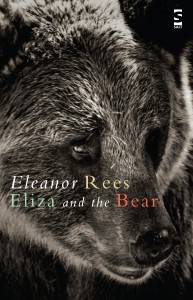 Eleanor Rees’s first collection, Andraste’s Hair was shortlisted for Best First Collection in the 2007 Forward Prizes and for the 2008 Glen Dimplex Poetry Award. In her second full-length collection she continues to play the role of mythologiser and tale teller, moving away from her previous subject, the imagined city, into the magical psyches of changeling creatures.
Eleanor Rees’s first collection, Andraste’s Hair was shortlisted for Best First Collection in the 2007 Forward Prizes and for the 2008 Glen Dimplex Poetry Award. In her second full-length collection she continues to play the role of mythologiser and tale teller, moving away from her previous subject, the imagined city, into the magical psyches of changeling creatures.
In powerful nocturnal encounters silent visitors travel from the dark world, take on elemental form and embrace Rees’s narrators with sensual and erotic urgency. Laced with tales of physical transformations, Rees’s use of fairy stories and night visions radically reimagines the female experience through the psychic collisions of the body and our desires.
Eliza and the Bear offers a man who gives birth, trees that sing, a dissolving house, a woman trapped in walls, a peasant farmer in his barren fields, the wife of a Victorian botanist who longs for a child while her husband ‘discovers’ the new world, winter songs and red hot hearths: mysterious forces which have their home within us all.
Eliza and the Bear
by Eleanor Rees
Yes, Eliza and the Bear is the book the band is named after! Listen to them here http://elizaandthebear.com/
Reviews of the collection:
‘Rewilding’ is a vogue idea in conservation biology. Even while the twentieth century has seen the development of the modern conservation movement that seeks to preserve habitats and species across the world, extinctions have increased at an alarming rate. Even in the protected areas of wilderness that constitute national parks, now ubiquitous around the world, species are disappearing. This appears to be because man-made wildernesses are just not wild enough: they are too small for the top predators – the lions, wolves and bears – which are essential for the environment to maintain a balance. Without these ‘apex’ predators, the ‘mesopredators’ – foxes, cats, snakes, etc. – become overabundant, wiping out populations, and ultimately entire species, of smaller creatures. Biodiversity declines, and habitats disintegrate. Rewilding involves the reintroduction of large, hungry carnivores to the environment, and rolling back human encroachment on the dangerous wilderness that is essential for the ecosystem. It’s a controversial approach, but these are urgent times.
Eleanor Rees’ acclaimed first collection, Andraste’s Hair (2007) spent most of its time in Liverpool, showing us a glittering, strange, not to say unreal city rendered in sensual and visceral imagery and language. Eliza and the Bear, her second, heads into the woods. More precisely, it constitutes a rewilding itself, heading into a wilderness of forests, rivers, crashing waves and thunderstorms, where the time is usually midnight or dawn, the weather is very hot or very wet, or both, and the figures that appear are half-seen, anonymous and mainly animal, including, of course and most frighteningly, bears. The colours are intense, the images bloody, and crisis is never far away: a happy ending is never assured. The world is a fabulous one, in the best sense of a fairy tale, with all the magic and violence that promises.
The centrepiece of this book is the long title sequence itself, which has been presented in performance as a collaboration between Rees, the harpist Rebecca Joy Sharp and the actor Cathy Butterworth. The sequence has some of the marks of being devised in this specific context, but does also work effectively alone: a sustained piece of dramatic and expressive writing that merges voices of a female figure and her bear-lover in a darkly erotic series of encounters.
I did not know there would be no relief from the tides
that pull on my belly day and night.I did not know footsteps at the full moon
tapping across the moonlit garden,
baby hare between your teeth.(‘Eliza and the Bear’, s.1)
The moon looms large and the currents are strong; menstruation and being eaten are very close together, and the generative and destructive possibilities of both are terrific and terrifying, loved and feared. It is this battle – and the larger conflict that it points towards, of how to come to an accommodation of human reason with the natural world – that gives the poem much of its power. Perhaps the fullest expression of Rees’s vision in these terms comes in a shorter poem in the collection, ‘Spillage’, which reads like an early study for the larger sequence:
Inside here I find blood, marrow,
purple-ordered brain, openings of lungs.How to move through these?
How to find myself there?To curl under a weight of self
and sleep at the centre and be sure.(‘Spillage’, ll.15-20)
The questions asked here appear to remain unanswered, which suggests that the writer knows they might not be the right questions: Rees’s poetry is not about finding a way of sleeping at the centre but, rather, savaging the marrow. At the end of ‘Eliza and the Bear’ the human and bear voices and bodies merge ‘in flesh and blood, in warmth and animal sense’, one inside the marrow of the other.
The approach of this collection owes much to Angela Carter’s magnificent The Bloody Chamber (1979), which did not so much offer subversively twisted accounts of traditional fairy tales as devise new stories that tapped into the latent core of violent sexuality that underpins so many of them. Rees does not explicitly rework existing fables or fairy tales herself, but there is a strong sense that her poems are tapping into the same imaginative root. Like Carter, she ‘re-wilds’ her material, re-introducing teeth, blood and danger into a world that is suddenly, thrillingly, beyond our human understanding again.
Will Carr, Hand + Star